You'll find three effective methods for cooking red lentils outdoors. The campfire Dutch oven method uses hot coals, oil, and seasonings with a 3:1 water-to-lentil ratio for a 15-minute cook time. The solar cooker option harnesses sunlight through reflective surfaces and dark pots, reaching up to 300°F with a 2.5:1 water ratio. For lightweight backpacking, try the dehydrated trail prep method – cook lentils at home, dehydrate them, then rehydrate on the trail with boiling water in a 1:1 ratio. Each technique offers unique advantages that can transform your outdoor cooking experience.
Campfire Dutch Oven Method
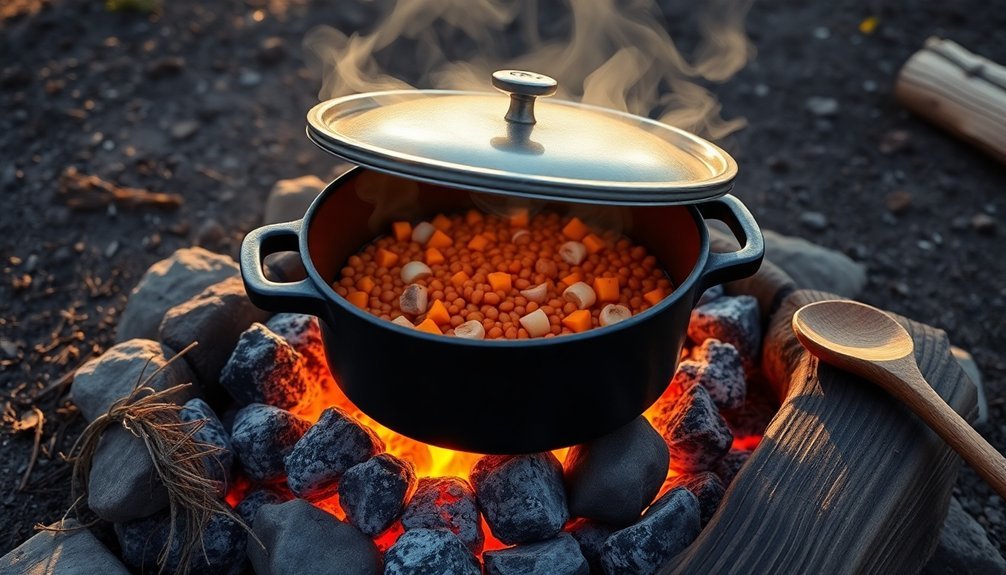
The campfire Dutch oven method offers a traditional way to prepare red lentils in the great outdoors. Before you begin cooking, sort your lentils on parchment paper to remove any debris, then rinse them in a fine mesh strainer until the water runs clear.
Start by positioning your Dutch oven over hot coals, then heat your oil. Add diced onion, garlic, garam masala, and salt, cooking for 1-2 minutes.
You'll need 3 to 4 cups of water or broth for each cup of lentils you're preparing. Once you've added your liquid, cover the pot and let it cook for about 15 minutes.
Managing your heat is vital when cooking over a campfire. You can adjust the distance between your Dutch oven and the coals or use a cooking grate for better control. To maintain clarity and consistency in your cooking process, organize your ingredients using parallel structure when preparing them. Stir occasionally to prevent the lentils from sticking to the bottom.
You'll know they're done when they're tender and most of the liquid has been absorbed.
For safety, always use proper heat-resistant equipment when handling your Dutch oven, and make certain you're cooking in a well-ventilated area. You can adjust the cooking time based on your altitude and weather conditions.
Solar Cooker Basics
Solar-powered cooking offers an eco-friendly alternative for preparing red lentils outdoors while harnessing natural energy.
You'll find that solar cookers convert sunlight into heat through a simple process that uses reflective surfaces and dark-colored pots to maximize heat absorption. These cookers can reach temperatures of up to 150°C (300°F), making them perfectly suitable for cooking lentils. Even during days with partial cloud cover, your lentils will continue cooking thanks to the insulated design of solar box ovens.
When you're cooking red lentils in a solar cooker, you'll need to use 2 ½ cups of water for each cup of lentils. Place your ingredients in a dark pot within the cooker's greenhouse enclosure, which traps heat and prevents it from escaping.
You can adjust the temperature by positioning the reflectors and verifying proper insulation.
You'll appreciate that solar cookers aren't only environmentally friendly but also cost-effective since they don't require fuel. They're safe to use and require minimal maintenance.
While cooking times may vary depending on solar intensity and the type of cooker you're using, you can monitor the temperature with a built-in thermometer if your model has one.
The enclosed design guarantees even cooking, producing perfectly tender red lentils.
Trail Dehydrated Lentil Prep
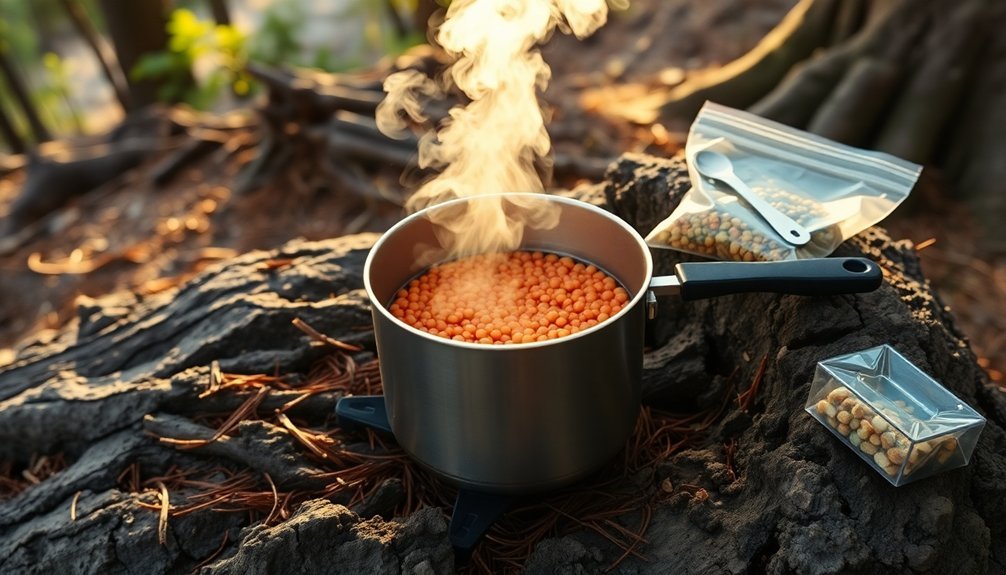
Beyond solar cooking, preparing dehydrated red lentils offers an excellent option for outdoor enthusiasts planning multi-day adventures. You'll want to start by cooking your lentils at home using either the stovetop or Instant Pot method. Cook them until they're firm but tender, typically 15-20 minutes on the stovetop or 10 minutes in the Instant Pot, to maintain their texture through the dehydration process. Adding three cups water per cup of lentils ensures proper cooking consistency.
Once cooked, spread your lentil mixture thinly on lined dehydrator trays, being careful not to overload them. Dry at 135°F for 8-12 hours until they're completely dry and crumbly. Let them cool fully before storing in airtight containers.
When you're ready to eat on the trail, you've got several rehydration options. The simplest method is adding boiled water in a 1:1 ratio and waiting 10-15 minutes in an insulated container.
For the freezer bag method, you'll need to wait about 25 minutes. To enhance flavor, you can add seasonings like soy sauce, salt, and pepper during preparation.
Remember to portion your dried lentils before your trip, aiming for about 1.5 cups per serving to guarantee you'll have enough sustenance for your outdoor adventure.
Frequently Asked Questions
Can Red Lentils Be Safely Cooked at High Altitudes Without a Pressure Cooker?
Yes, you can safely cook red lentils at high altitudes without a pressure cooker. You'll need to extend cooking time, reduce water ratio, and use a covered pot to prevent rapid evaporation and guarantee proper doneness.
How Long Do Cooked Red Lentils Last in a Backpack Without Refrigeration?
You shouldn't keep cooked red lentils in your backpack without refrigeration. They'll only stay safe for up to 2 hours at room temperature. After that, you're risking dangerous bacterial growth and foodborne illness.
What's the Best Way to Prevent Red Lentils From Becoming Mushy?
You'll prevent mushy red lentils by using a 3:1 water-to-lentil ratio, cooking for just 5-7 minutes, and watching them closely. Don't add salt while cooking, and remove from heat immediately when tender.
Should I Pre-Soak Red Lentils Before Cooking Them Outdoors?
You don't need to pre-soak red lentils since they cook quickly in 15 minutes. However, if you're concerned about digestibility, a 6-hour soak can help reduce bloating and improve nutrient absorption.
Can I Use Creek Water to Cook Red Lentils While Camping?
You can use creek water to cook red lentils, but you must boil it for at least 1 minute first to kill harmful pathogens. Don't skip this essential purification step to avoid waterborne illnesses.
In Summary
Whether you're using a sturdy Dutch oven over hot coals, harnessing the sun's energy with a solar cooker, or rehydrating trail-ready lentils at your campsite, you'll find red lentils are perfect for outdoor cooking. They're quick-cooking, nutritious, and incredibly versatile. You can't go wrong with any of these methods – just pick the one that matches your gear and camping style best.

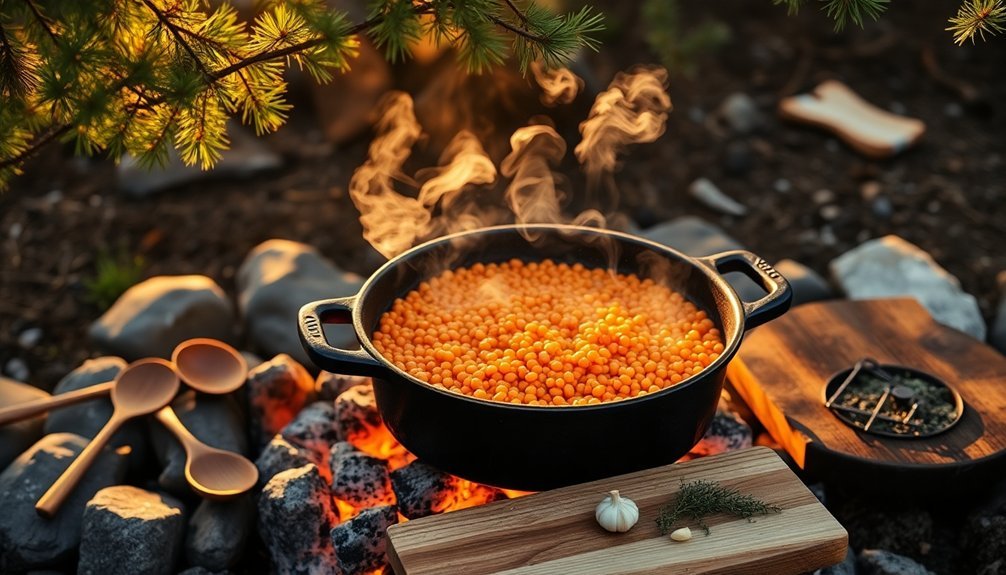
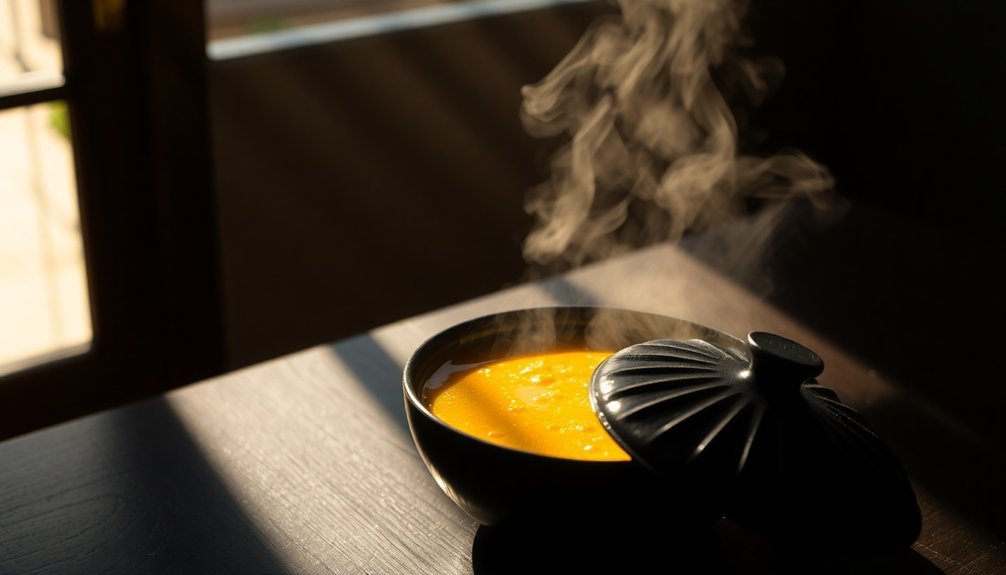

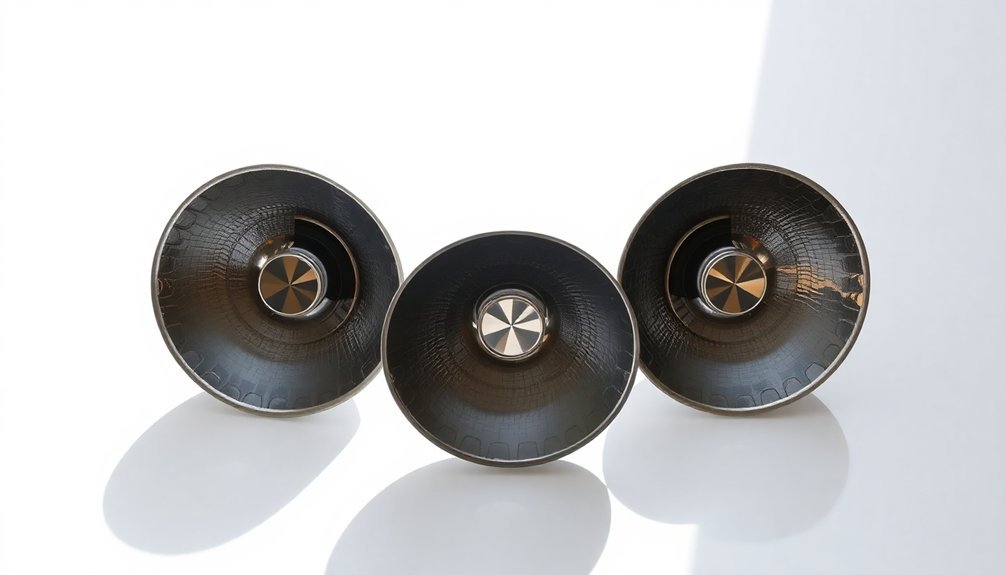
Leave a Reply